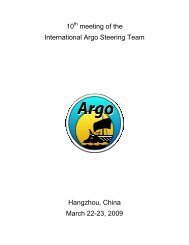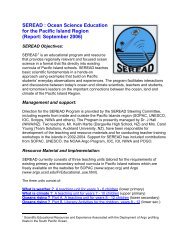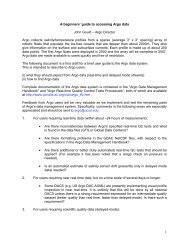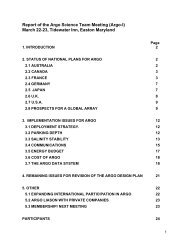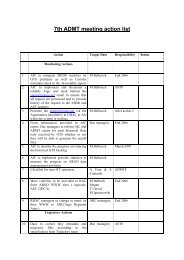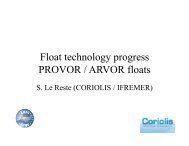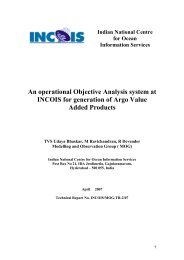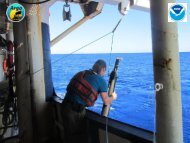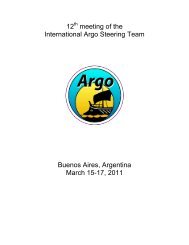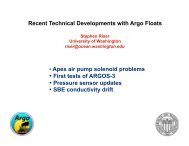11 meeting of the International Argo Steering Team Scripps ...
11 meeting of the International Argo Steering Team Scripps ...
11 meeting of the International Argo Steering Team Scripps ...
You also want an ePaper? Increase the reach of your titles
YUMPU automatically turns print PDFs into web optimized ePapers that Google loves.
Until now, it was possible to define two zones with different vertical sampling resolution: a<br />
deep zone and a shallow zone. The transition depth (500 dbar for instance) and <strong>the</strong> bin size (25<br />
dbar in <strong>the</strong> deep zone below 500 dbar and 10 dbar above) are defined by <strong>the</strong> user. It is now<br />
possible to define a third zone near <strong>the</strong> surface with high-resolution sampling (1 dbar bin<br />
average for instance). This will be implemented on 14 Arvor floats.<br />
Three Arvor prototypes have been deployed in 2009 and have successfully achieved <strong>the</strong>ir<br />
missions. Two are still active and should have completed 200 cycles by end <strong>of</strong> March. A<br />
commercialisation licence should be established in 2010. The overall objectives <strong>of</strong> <strong>the</strong> ARVOR<br />
floats are: 250 cycles at 2000m, continuous pumping for <strong>the</strong> CTD, <strong>11</strong>0 points transmitted by<br />
cycle.<br />
The Iridium transmission has been implemented on 2 Arvor floats. The first float (WMO<br />
6900794) has been deployed in <strong>the</strong> Med Sea from <strong>the</strong> TARA (collab. with OGS) at <strong>the</strong> end <strong>of</strong><br />
2009. 99 cycles have already been done (1 cycle/day). The float transmits 2 dbar bin-averaged<br />
data and 1 spot sampled triplet at 2 dbar. The downlink communication has been successfully<br />
tested as well as <strong>the</strong> grounding procedure. The second float (WMO 1900848) has been<br />
deployed in <strong>the</strong> Adriatic in Feb 2010. 5 cycles have already been done (1cycle every 5 days).<br />
The float also transmits 2 dbar bin-averaged data and 1 spot sampled triplet at 2 dbar.<br />
Two ARVOR floats with ARGOS 3 transmission are in construction by NKE. The floats should<br />
be deployed in 2010 in <strong>the</strong> Med Sea (contribution to Euro<strong>Argo</strong>). They will surface according to<br />
<strong>the</strong> predicted passage <strong>of</strong> A3 and <strong>the</strong>y will send 1Koctet <strong>of</strong> data over 1 pass. A testing platform<br />
has been developed to help define <strong>the</strong> transmission strategy. Good results have been obtained<br />
in <strong>the</strong> lab.<br />
We are currently investigating <strong>the</strong> feasibility <strong>of</strong> developing high-pressure pr<strong>of</strong>iling floats. We<br />
should be able to conclude in 2010. Finally, we also investigate <strong>the</strong> feasibility <strong>of</strong> measuring<br />
nitrates from PROVOR floats.<br />
Deep NINJA<br />
Tsurumi Seiki Co. Ltd. (TSK), in cooperation with JAMSTEC, is developing a new pr<strong>of</strong>iling float<br />
for a depth greater than 2000 dbar: Deep NINJA. It has a new buoyancy engine, which is a<br />
hybrid system <strong>of</strong> single-stroke piston engine and hydraulic pump engine. The prototype<br />
hardware <strong>of</strong> Deep NINJA will be finished to be assembled probably in summer 2010 and <strong>the</strong><br />
field tests will be done within a year. While <strong>the</strong> buoyancy engine <strong>of</strong> <strong>the</strong> prototype <strong>of</strong> Deep<br />
NINJA was originally designed for <strong>the</strong> maximum operation depth <strong>of</strong> 3000-dbar, its laboratory<br />
test indicated that <strong>the</strong> engine functioned very well even at 3500 dbar, which is <strong>the</strong> safety limit <strong>of</strong><br />
<strong>the</strong> pressure tank. It is likely that <strong>the</strong> engine works at a greater pressure level. JAMSTEC<br />
hopes that TSK improves it to be good for <strong>the</strong> depth <strong>of</strong> up to 4000 dbar.<br />
SOLO-II<br />
Dean Roemmich reported that <strong>the</strong>re are now two SOLO-II prototype floats in <strong>the</strong> ocean<br />
operating at accelerated cycling intervals, and <strong>the</strong> first production run <strong>of</strong> about 30 S-II floats is<br />
planned for later this year. Attributes <strong>of</strong> <strong>the</strong> S-II include its small size (40 cm shorter than<br />
SOLO), light weight (19 kg), low energy consumption for long life (> 200 cycles), 2000 m depth<br />
capability anywhere in <strong>the</strong> world, Iridium communications, and no air bladder. While <strong>the</strong> basic S-<br />
II is small, <strong>the</strong> instrument is scalable for additional batteries, sensors, and o<strong>the</strong>r features.<br />
21



